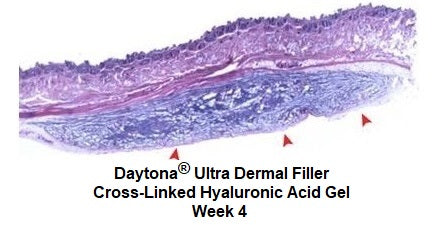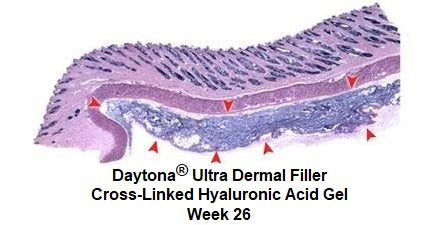Straight Talk about Hyaluronic Acid and Microneedling
SUMMARY
Inducing Collagen production is the primary reason for microneeding. Genuine Hyaluronic Acid works synergistically with the microneedling process and boosts the growth of the Collagen induced by microneedling, giving a more robust and longer lasting result. Unfortunately, most of the "Hyaluronic Acid" skin creams and serums in the USA do not actually contain any Hyaluronic Acid!
Genuine Hyaluronic Acid (Injection Grade)
As we grow older, natural levels of Hyaluronic Acid in our bodies decline with age. As a consequence of lower Hyaluronic Acid levels, Collagen declines, and the appearance of wrinkles become more visible. Maximizing Collagen levels will keep skin supple. Hyaluronic Acid keeps Collagen synthesis up, as well as retaining skin moisture, providing anti-aging benefits to the skin. Higher levels of Collagen and Hyaluronic Acid are related to skin that is more supple and resistant to wrinkles and fine lines. The purest form of genuine Hyaluronic Acid for medical applications is commercially available with the name, "Injection Grade Hyaluronic Acid." Injection Grade Hyaluronic Acid has two main properties that are critical for skin rejuvenation:
1) Deep Hydration
Researchers have found Hyaluronic Acid supplementation to be directly correlated to measurable increases in skin moisture. Microscopic skin surface analysis shows increased skin smoothness and amelioration of wrinkles.
2) Collagen Growth
Hyaluronic Acid plays a critical role in the production of Collagen, the most abundant protein in the body. Collagen feeds on and grows from Hyaluronic Acid. Collagen is critical to the skin because it supports skin structure. Hyaluronic Acid is critical because it promotes the growth of Collagen.
The Evolution of Hyaluronic Acid in Skin Cream
It is logical to think that Hyaluronic Acid would be a perfect ingredient for skin creams or skin serums because of its ability to provide deep hydration and promote the growth of Collagen. Skin cream companies thought so too! But they quickly found a problem.
The problem was that the molecules of genuine Hyaluronic Acid like to form themselves into chains ... big long chains. These chains are too big to penetrate the skin when applied topically in a skin cream. To achieve a benefit from Hyaluronic Acid, it must be injected or microneedled into the skin. So, for topical application in a moisturizing skin cream, genuine Hyaluronic Acid is useless ... it just sits on top of the skin doing nothing.
The skin cream companies experimented and found that they could chemically treat Hyaluronic Acid to neutralize the molecule and create a different molecule named Sodium Hyaluronate.
Sodium Hyaluronate molecules are small enough to penetrate the skin when applied topically, for example, in a skin cream. It retains the deep moisturizing properties of its big brother Hyaluronic Acid which makes it a perfect moisturizing ingredient for skin cream, and in fact, today it is the most popular moisturizing ingredient for skin cream. Something like 95% of all Hyaluronic Acid is converted to Sodium Hyaluronate for use in skin creams.
Unfortunately, because Sodium Hyaluronate is a synthesized molecule that does not naturally occur in your body, even if you inject it or microneedle it, your Collagen will not recognize the Sodium Hyaluronate, and therefore it will do absolutely nothing to promote the growth of Collagen.
Sodium Hyaluronate (Cosmetics Grade)
We have tested 42 different Hyaluronic Acid skin serums used for microneedling in our lab. We were very surprised when we found that none of them contained Hyaluronic Acid. They all contained Sodium Hyaluronate. Don't believe this??? Check the ingredients list of any Hyaluronic Acid serum ... odds are you will find Sodium Hyaluronate in the ingredients list ... not Hyaluronic Acid.
Often it is said that Sodium Hyaluronate is just a different name for Hyaluronic Acid. It's not. Do not be misled. Sodium Hyaluronate is NOT Hyaluronic Acid. It is a different molecule. Molecular weight is very specific ... exact!
Remember the Periodic Table of the Elements hanging on the wall in science class? Each element on the Table has a specific atomic mass. Elements are combined into molecules and the molecules are differentiated by molecular weight which is the molecule version of atomic mass. Hyaluronic Acid is a molecule with a very specific molecular weight. Sodium Hyaluronate is a different molecule with a different molecular weight. They are not the same.
I make a joke when I see Sodium Hyaluronate being passed off as Hyaluronic Acid. I think of a man telling his girlfriend ... "My darling! I love you! I want to marry you! I bought you a ring! It's made of Lead, but if you look at the Periodic Table of the Elements it's right on the same line with Gold and Platinum!!!" Lead is definitely not Gold. And Sodium Hyaluronate is definitely not Hyaluronic Acid.
Sodium Hyaluronate is not a naturally occurring substance that is found in the skin. It is a synthesized byproduct of Hyaluronic Acid that has been degraded by a chemical process to neutralize the molecule so it can enter the skin when applied topically. Sodium Hyaluronate retains the deep hydrating property of Hyaluronic Acid, but it does not have the ability to promote the growth of Collagen.
Histopathology Photos
When we discuss Hyaluronic Acid, and talk about how Collagen feeds on and grows from Hyaluronic Acid, we are sometimes questioned about this. So we made a series of Histopathology Photos over 26 weeks using Daytona Ultra, our Cross-Linked Hyaluronic Acid Dermal Filler (sold only in Europe). Lets look at the photos and see the mechanism of how the Hyaluronic Acid works in your body.




Week 26: The arrows are pointing at something at the bottom of the photo, stained blue its all Collagen. The Collagen has metabolized all the Hyaluronic Acid and now, after 26 weeks, the wrinkle is still completely filled but now it is completely filled only with Collagen. The Hyaluronic Acid is gone. What happens next is that without any more Hyaluronic Acid there to feed the Collagen, the level of Collagen will start to diminish and the wrinkle will start to reappear. Eventually the wrinkle will completely return as the Collagen continues to diminish down to zero due to the lack of Hyaluronic Acid. Of course, long before this happens, we will want to introduce a "maintenance treatment of Hyaluronic Acid to refresh the matrix of Hyaluronic Acid already in the skin, to maintain the Collagen levels, so the wrinkles stay filled.
Final Thoughts
Your body needs Hyaluronic Acid to nourish and feed your Collagen. As you age, your body's natural production of Hyaluronic Acid declines. Your body is still producing Collagen, but without enough Hyaluronic Acid to sustain the Collagen produced, your Collagen levels will drop-off and your skin will develop wrinkles.
Microneedling induces the production of Collagen. But you must support the Collagen production and supplement your body's natural Hyaluronic Acid levels by microneedling together with a serum containing Hyaluronic Acid.
Daytona Serums contain genuine Hyaluronic Acid that boosts the growth of the Collagen induced by microneedling, giving a more robust and longer lasting result that is impossible to achieve with the Sodium Hyaluronate serums that exist out there masquerading as Hyaluronic Acid.
Microneedle in a series of treatments with Daytona Serums until you achieve the result you are looking for. The Hyaluronic Acid in Daytona Serums will persist in the skin for about 60 days. Come back once every two months for one "maintenance" microneedling treatment, to refresh the matrix of Hyaluronic Acid and support the Collagen production that you induced during the initial treatments.
Consult your doctor or esthetician for a treatment plan tailored for you.
